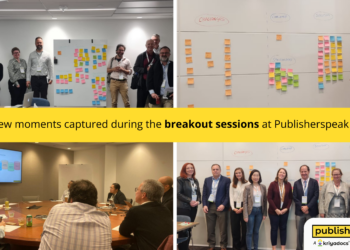
It’s easy to depict groups as caricatures. The traditional caricature of the scientist is someone in a white lab coat, toiling tirelessly for a breakthrough that will benefit humanity, willing to make his findings public, and supporting other scientists doing the same.
There is some truth to this depiction. Science is based on openness as researchers communicate their findings at conferences and release them publicly in scientific journals. Scientists are good at collaborating, and you can see evidence of this in author lists, which seem to grow longer, recognizing more contributors, and involving more institutional bodies in more countries each year.
But there is a limit to the degree of sharing that goes on amongst academic scientists. Science rewards first discoveries, so sharing detailed information about what one is doing always comes with the risk of being scooped (beaten to publication). Even after publication, scientists are reluctant to share data even for verification purposes, as documented in a study of data requests to PLoS authors.
So while academic scientists are ideologically supportive of openness, they also practice some degree of secrecy, which seems to be largely ignored in discussions surrounding science policy.
In a paper published in the October issue of Social Studies of Science titled “Industry collaboration, scientific sharing, and the dissemination of knowledge,” (free preprint here) James Evans investigates the influence of industry on sharing in science. Evans is a sociologist at the University of Chicago, and author of several other notable studies on the effect of online journals and open access on citation behavior. He is someone equally at ease with the techniques of critical theory as he is with advanced statistical methods, and in this case he combines them both.
In his paper, Evans focuses on plant scientists, and more specifically, those doing work on Arabidopsis thaliana, a wild relative of the mustard plant. Arabidopsis was the first plant to have its entire genome sequenced and serves as a model organism, much like the fruit fly or Zebrafish. A great deal of work on Arabidopsis is sponsored, in part, by agricultural and biotechnology companies.
Combining ethnographic methods with computational techniques, Evans is able to build a more complex and realistic picture of scientific behavior. He reports that scientists actively share findings of their research, but they act much more strategically in what is shared and who they share with. And for good reason:
To maximize the likelihood they will publish first, scientists seek out others’ intermediate findings while concealing their own. Competition creates paranoia over being ‘scooped’ or beaten to publication by others, sometimes with one’s own disclosed data. . . . As a result, scientists dole out ideas and results selectively, even when they publish completed findings quickly.
Not all scientists are good at keeping secrets, Evans reports. When working with industry partners, academics often forget that industry operates under a different culture of sharing information, where knowledge can act as a competitive advantage over one’s rivals. Operating in a more public sphere, Evans writes, academics have a tendency to fall back on the default of sharing:
It is not that academic scientists never kept secrets, but that many did so badly: they could be unpredictable, would routinely communicate with others across institutional boundaries, and despite non-disclosures, let things slip.
The results of Evan’s citation analysis also suggest that industry sponsorship impedes the broad dissemination of scientific ideas, or, to be more precise, “reduces the distance that ideas travel from industry-sponsored labs.” On the other hand, collaboration with industry did engage new authors and institutions on topics not supported by government grants.
Finding that balance between openness and secrecy is important for the ultimate progress of science, and neither extreme is ideal. Evans concludes his paper with a warning against mandating open sharing in science:
In the name of scientific advance, governments have considered attempting to force academics to share, but the cost would be high. Not only would government oversight change the way many academics operate, regardless of industry ties, but fewer relationships with industry and the development of fewer marketable technologies would likely result.
The open secret here is that science depends on a balance of competitive drives and cooperative culture. Pushing it too far in either direction will likely cause inadvertent harm.
Discussion
5 Thoughts on "Openness and Secrecy in Science — A Careful Balance"
No mention of the effect of patents on secrecy here? That’s an obvious exception to the culture of openness. One cannot, legally, qualify for a patent if the idea on which it is based becomes “public” before the patent is secured. This affects some sciences more than others, for example, chemistry much more than theoretical physics.
Good point. Technology transfer income is the elephant in the room that never seems to be mentioned when talking about access and openness. If US taxpayers have a right to access the results of research paid for by their tax dollars, then doesn’t it follow that those results should not be locked up by patents for researchers and universities?
Telling universities they’ll save money by not paying for journal subscriptions is an easy argument to make, convincing them to give up substantial amounts of income ($154 million in 2009 at Columbia University alone) may be a tougher sell. Every institute where I’ve worked has relied heavily on their patent portfolios as a significant part of their operating budget and researchers greatly supplemented their incomes as well. When I was at Caltech there was a long-running joke about the university building a restricted “Porsche-only” parking lot for the faculty.
Also, as Phil alludes to in the article, there’s the question of commercial development, and whether it’s encouraged by restricted licensing. According to this report, the system works well for getting research discoveries into the hands of the public. Will companies be as eager to develop technologies without any exclusive rights?
I authored the article about which Phil writes…I link to the article and a preprint (to those without access) on my research site at:
http://home.uchicago.edu/~jevans/Jamesweb/research.html
On patents, research in the U.S. by Toby Stuart and others shows that a flurry of patents are positively associated with publishing (the same things), but this is not the case in the UK and Europe where a grace period for publishing is not granted. The influence of the possibility may well be to nudge research toward patent-able areas and away from those less patentable. This is partly what my findings show–that commercial researchers prefer to research in less crowded areas where there is legal “freedom of action” to patent and use the IP to develop stand-alone products. A recent finding by Scott Stern and Fiona Murray also shows that when something is patented, researchers stop asking for it, regardless of whether the inventors would be willing to share.
A forthcoming paper of mine on industry collaboration in the American Journal of Sociology (preprint available at the site above) also shows that the commercial drive for less crowded research areas actually injects novelty into successful scientist’s otherwise conservative work.



